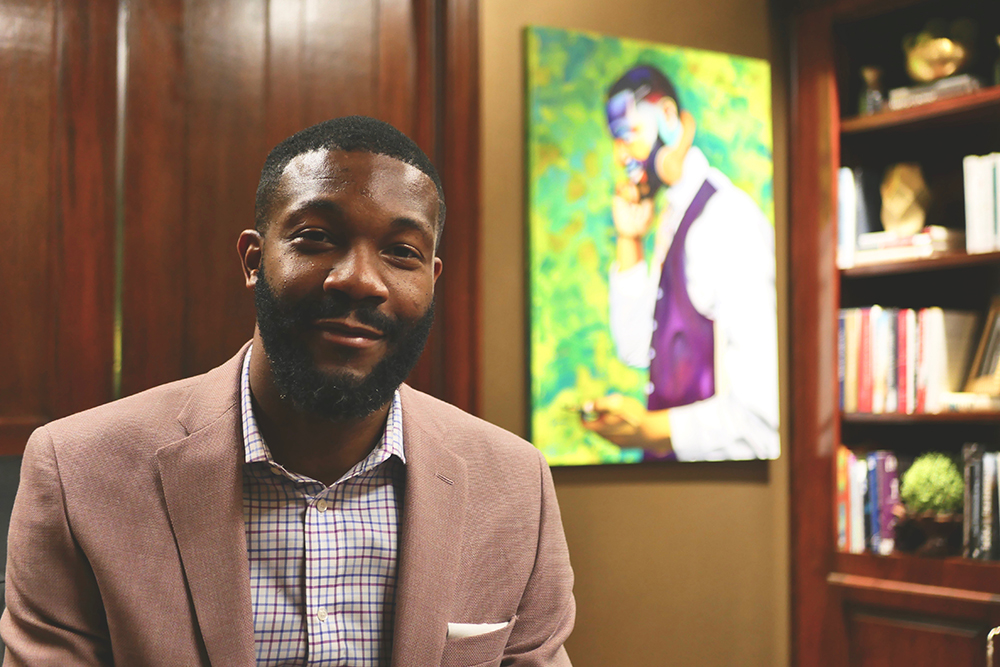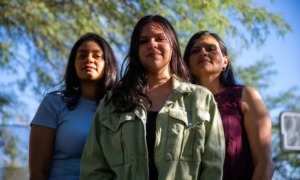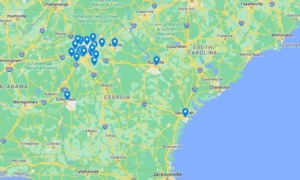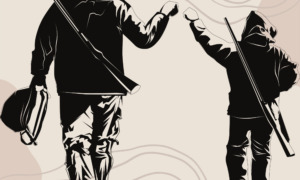
Katherine Webb-Hehn
Birmingham Mayor Randall Woodfin in his office at City Hall.
BIRMINGHAM, Ala. — Mayor Randall Woodfin says Birmingham is ready for peace.
With a call for communitywide investment, the mayor says it’s time for solutions — “not programs” — for a city long plagued by violence.
In Birmingham, it’s an ambitious goal. In 2018, Birmingham had the most gun-related homicides in the state with 107 victims.
This March, the mayor’s office declared gun violence a public health crisis, releasing a strategy from the Peace & Policy office, including strengthened community policing and witness cooperation, a reentry task force for restorative justice and a community-based research and educational facility where residents will be engaged in developing solutions for “the most pressing social issues facing their neighborhoods.”
I sat down with Woodfin in his office while reporting a story about efforts to decrease gun violence. Here’s an excerpt from the interview, edited for clarity, about his plans.
Webb-Hehn: Various organizations, public and private, have tried to address gun violence in Birmingham, but there have been issues with communication, cooperation and collaboration. Is it the mayor’s job to make sure those various organizations work together?
Mayor Woodfin: In Birmingham, unfortunately, one of our Achilles heels has always been our silos. I do try to bust down those silos.
I acknowledge that sometimes when you step out front and lead, people assume you have all the answers. We acknowledge we don’t have all the answers.
I think there are more solutions than problems to this issue. How do you get everybody to the table on this issue? That’s not always easy, especially when there are a limited amount of resources.
I’ve always looked at addressing gun violence as a holistic approach. … Part of enforcement is community engagement. How are our officers building relationships in the community? What’s the rapport with the community? What’s the rapport with neighborhood leaders, residents, small business owners?
If a strong, positive rapport exists before conflict, people feel comfortable to engage their beat officers because a trusting relationship exists. I think that has existed some, but we need to make that wholesale for every beat, for every precinct for the entire city.
Since Jan 1, 2019 … we have taken 571 [unlawfully held] guns off the streets of the city of Birmingham. That’s a lot of guns removed off the street.
Hopelessness, not just poverty
W-H: Homicide victims here are 89% African American males between 19 and 34. Can you talk about the reality of that weight?
MW: It’s a reality that’s too heavy. There are too many grieving mothers in this city.
I want to say this because it needs to be said: Poverty has been in the black community since slavery existed. Homicides among black people, whether it’s the ’80s or the time we’re in now, they haven’t always been this consistent. We like to say: “This exist because of poverty.”
But my response to that is: We need to go levels deeper.
The thing that always comes out is hopelessness. … [Hopelessness] creates a window for people to have a reckless disregard for their own life, [which] puts you in a position to have a reckless disregard for someone else’s life, and that, in turn, allows for when you have an issue with somebody, your form of conflict resolution is to pick up a gun and pull the trigger — and not think twice, or even once — about someone else’s life.
I’m reflecting back on the 16 months I’ve been mayor. One of the most jaw-dropping moments I’ve had was to go speak to some young people who are in custody, locked up next door in the detention center at family court.
With another adult present, I got the opportunity to interact one on one. I talked to seven of them, between the ages of 15 and 17. Five or six of seven [cases] involved them having a gun or the person they were with had a gun. I was like, “Tell me about home. Tell me about your community. Tell about how you feel about it.”
What I found consistently was the look in their eye. How does a young person at 15, 16, 17 already have hopelessness? What happened at home? What happened in their community? What happened at school? What happened at church? What happened at that early of an age?
Gosh, it’s not just some form of hopelessness, but they’re also not afraid — at 15, 16, 17 — to be locked up.
There was no fear in their eyes. There was a lot I was looking for in their eyes. I was looking for sadness. I was looking for hope. I was looking for: I want to get out of here, and when I get out of here, I want to choose different options.
So, as adults, what paths are we creating for different options? Even as young people, they’ve entered the system so going home is reentry. They’re still young enough so you can prevent some things when they get out.
W-H: How did you feel in that situation expecting remorse and not seeing it?
Woodfin: There were several of them who had an accomplice who got away. At 15, 16, 17 they’ve already bought into the culture of no snitching. A couple of them didn’t even have the gun. The other person had the gun, but they didn’t want to say who. So, it’s just a badge of honor. … Who’s teaching that culture to our children?
This ability to pull a trigger in the middle of conflict? I’m not comfortable with it.
W-H: The new peace policy includes language about the city’s services being “trauma informed.” How do residents experience trauma?
Woodfin: Let’s be honest. When we talk about poverty in Birmingham, it’s not just poverty, it’s concentrated poverty.
We often talk about post-traumatic stress isolated to folks who return home from conflict in the war. No one talks about present traumatic stress in children who see violence.
There is too much present traumatic stress in the Birmingham community. The way to fight against it, in my job as Birmingham mayor is: How do you be strategic in the resources you put into it so that you can see change? That’s nothing you can change in 15 months, but you do have to start laying the foundation to see incremental growth in people choosing different options.
How to allocate city funds
W-H: You’ve said tax dollars are limited, and there are certain things the city has to provide. How do you allocate dollars to address violence?
MW: It’s wholesale neighborhood revitalization. How a neighborhood looks, for starters. We see not just blight, but an inoperable vehicle in a neighbor’s yard, litter. That’s a distress signal. Is our neighborhood being taking care of?
In Central Park [a neighborhood in Birmingham’s West End], for example, some arsons went through there back in ’17. Burned a lot of structures. I got a picture today because I went through there physically walking through there several weeks ago, and I told them I don’t care where those houses are. … [Today, the city] took them all down.
Children shouldn’t physically see something like that every day. When you see that every day, it’s a signal nobody cares about what’s happening in your neighborhood. If it physically looks like that, then mental energy that’s spent there, and the emotional energy that’s spent there, people shortchange it.
The physical space where a person lives, the city’s job in my opinion is to clean it up. That’s then supplemented by wraparound services. If you have limited local tax dollars, you have to partner with the state and federal governments. With the fed government, what dollars exist from the Department of Justice for prevention? With the state, what programs exist for workforce development and workforce training?
From an educational sense, how will we support apprenticeships and summer work opportunities so that if they’re at work, we know they’re not out on the streets.
How do we support the school system in creating scholarship programs [so kids] can go to college? People who are smart but possibly can’t afford college stay home and get in trouble or have to support home so they end up doing illegal activities to make ends meet.
That’s how we support. That’s how we fight against.
That’s the foundation of what the city tax dollars are supposed to provide: infrastructure and police. Everything else is the additional stuff we do in conjunction and support.
W-H: The biggest criticism I hear of this administration thus far is that tax dollars are coming out of every community but only going into certain communities — the Legacy Arena stadium, for instance. What services fall under neighborhood revitalization?
MW: [Birmingham has a] $428 million budget; $3 million is less than 1%. I think people use the stadium as an excuse because they need a punching bag. They don’t talk about the other $425 million remaining, which is over 99% of the budget.
We’re going to put $1 million into apprenticeships. We’re going to put $1 million into scholarship opportunities. We’re going to put $1 million into full support services around families. We’re going to put millions into blight removal. We’re going to put $8 million into paving streets. I could go on and on.
Yes, I hear the criticism and this is my response: The City of Birmingham’s $428 million budget is the combination of sales tax, occupational tax and business license tax. I wish it was ad valorem, but it’s not.
The city of Birmingham is dependent on small business, entertainment and social. You support — with less than 1% of your budget — [the stadium] to get a return of more sales tax, business licenses and occupational [taxes] to go back into the 99 neighborhoods to address the issues you want.
You can fight the stadium but investing in the stadium will allow us to start a neighborhood revitalization fund. … We’ve torn down more than 400 [blighted] homes in the neighborhoods from this pot of money.
‘This is a will issue’
W-H: My goal with this reporting is to find services — what was happening before and happening now — and look for gaps in that network.
MW: We acknowledge there are gaps in services.
People will have you believe they’re not successful because of a lack of support from the city. It’s not a money issue. This is a will issue. I’m talking full community, not just the people who work specifically to address [gun violence].
Is there enough will in the community to say, “Too many lives have been lost. We’re tired of it”?
W-H: Do you believe enough people in the community feel that way?
MW: Yes. I believe that. What I also believe is that everybody wants to address it their way and not just sit at the table. In my position, there are people that say, “What’s the city going to do about all these homicides?”
One of the things we have to do is solve them. Guess how we solve them? Witness cooperation. We’ve seen an increase in less witness cooperation. We’ve seen an increase in “no snitching.”
In fairness, we’ve seen a legitimate increase in people who are afraid to come forward because of retaliation. Those things combined decreases our ability to bring to justice of some form to a family that will never be whole again. It also increases the likelihood of a fool to go out there and hurt people.
W-H: Is that why building community trust in police is one of the main goals of the peace strategy?
MW: It’s one of the reasons.
If 99% of your engagement and interaction with the residents and small business owners on your beat is in peacetime, you’ll have everything you need.
A simple way to test that is to simply ask an officer: How many people on your beat do you know by name?
The big overall reason why community trust is so important is because none of this works without relationships. There are drug houses right now in neighborhoods that folks know of.
If neighbors come together and surround a little trap house, dope house, whatever, and tell them, “No more,” they’ll shut it down. I’m hoping we get to a point where not just community trust is built but people feel empowered to shut down BS in their own neighborhood.
That’s power. You don’t need a nonprofit to do that. You don’t need the city to do that. You don’t need the police to do that.
“This is our neighborhood and we won’t stand for that.”
W-H: Do you think people will hear that and say, “That’s not my responsibility”?
MW: Yes, and you tell them it is their responsibility. You can’t have it both ways. The key word in neighborhood is neighbor. Neighbors have to band together to address the things they don’t want in their neighborhoods. It’s everything.
You can’t do a clean-up day once a year. You should probably do a volunteer “neighborhood clean-up day” every month. I guarantee if you did it once a month, it would decrease people’s thought process before they just drop stuff off on the ground at the neighborhood corner store because it would always be clean.
It’s the same with the illegal activity in the neighborhood. If you address it regularly, people will be less likely to do it.
W-H: If some miracle happened, and the nonprofits addressing gun violence in the city were fully funded and able to meet their goals of reducing homicides in the city, is there a financial benefit to the city? Grassroots groups seeking city funding believe so.
MW: You know what the benefit is? There’s less mothers joining the club they don’t want to be a part of, which is the loss of a son or daughter to homicide. I don’t care who gets the credit for decreasing homicides. We don’t care. We just want the grief and the loss of life to stop. That’s it.
This story was produced in conjunction with AL.com. It is part of the JJIE’s project on targeting gun violence. Support is provided by The Kendeda Fund. The JJIE is solely responsible for the content and maintains editorial independence.































